Zhi-Qi Cheng
HCMA: Hierarchical Cross-model Alignment for Grounded Text-to-Image Generation
May 15, 2025Abstract:Text-to-image synthesis has progressed to the point where models can generate visually compelling images from natural language prompts. Yet, existing methods often fail to reconcile high-level semantic fidelity with explicit spatial control, particularly in scenes involving multiple objects, nuanced relations, or complex layouts. To bridge this gap, we propose a Hierarchical Cross-Modal Alignment (HCMA) framework for grounded text-to-image generation. HCMA integrates two alignment modules into each diffusion sampling step: a global module that continuously aligns latent representations with textual descriptions to ensure scene-level coherence, and a local module that employs bounding-box layouts to anchor objects at specified locations, enabling fine-grained spatial control. Extensive experiments on the MS-COCO 2014 validation set show that HCMA surpasses state-of-the-art baselines, achieving a 0.69 improvement in Frechet Inception Distance (FID) and a 0.0295 gain in CLIP Score. These results demonstrate HCMA's effectiveness in faithfully capturing intricate textual semantics while adhering to user-defined spatial constraints, offering a robust solution for semantically grounded image generation. Our code is available at https://github.com/hwang-cs-ime/HCMA.
Securing the Skies: A Comprehensive Survey on Anti-UAV Methods, Benchmarking, and Future Directions
Apr 16, 2025Abstract:Unmanned Aerial Vehicles (UAVs) are indispensable for infrastructure inspection, surveillance, and related tasks, yet they also introduce critical security challenges. This survey provides a wide-ranging examination of the anti-UAV domain, centering on three core objectives-classification, detection, and tracking-while detailing emerging methodologies such as diffusion-based data synthesis, multi-modal fusion, vision-language modeling, self-supervised learning, and reinforcement learning. We systematically evaluate state-of-the-art solutions across both single-modality and multi-sensor pipelines (spanning RGB, infrared, audio, radar, and RF) and discuss large-scale as well as adversarially oriented benchmarks. Our analysis reveals persistent gaps in real-time performance, stealth detection, and swarm-based scenarios, underscoring pressing needs for robust, adaptive anti-UAV systems. By highlighting open research directions, we aim to foster innovation and guide the development of next-generation defense strategies in an era marked by the extensive use of UAVs.
Why We Feel: Breaking Boundaries in Emotional Reasoning with Multimodal Large Language Models
Apr 10, 2025Abstract:Most existing emotion analysis emphasizes which emotion arises (e.g., happy, sad, angry) but neglects the deeper why. We propose Emotion Interpretation (EI), focusing on causal factors-whether explicit (e.g., observable objects, interpersonal interactions) or implicit (e.g., cultural context, off-screen events)-that drive emotional responses. Unlike traditional emotion recognition, EI tasks require reasoning about triggers instead of mere labeling. To facilitate EI research, we present EIBench, a large-scale benchmark encompassing 1,615 basic EI samples and 50 complex EI samples featuring multifaceted emotions. Each instance demands rationale-based explanations rather than straightforward categorization. We further propose a Coarse-to-Fine Self-Ask (CFSA) annotation pipeline, which guides Vision-Language Models (VLLMs) through iterative question-answer rounds to yield high-quality labels at scale. Extensive evaluations on open-source and proprietary large language models under four experimental settings reveal consistent performance gaps-especially for more intricate scenarios-underscoring EI's potential to enrich empathetic, context-aware AI applications. Our benchmark and methods are publicly available at: https://github.com/Lum1104/EIBench, offering a foundation for advanced multimodal causal analysis and next-generation affective computing.
HA-VLN: A Benchmark for Human-Aware Navigation in Discrete-Continuous Environments with Dynamic Multi-Human Interactions, Real-World Validation, and an Open Leaderboard
Mar 18, 2025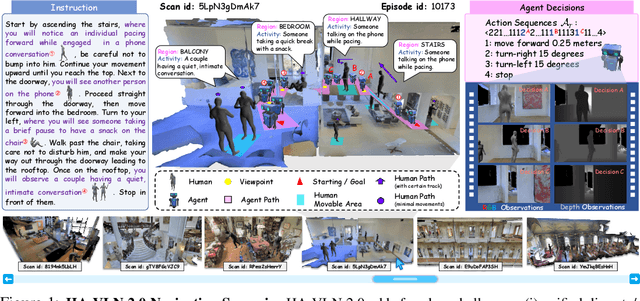
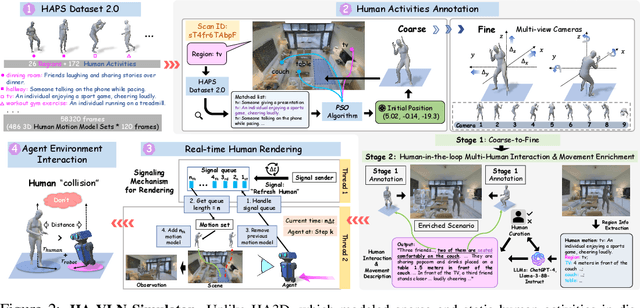
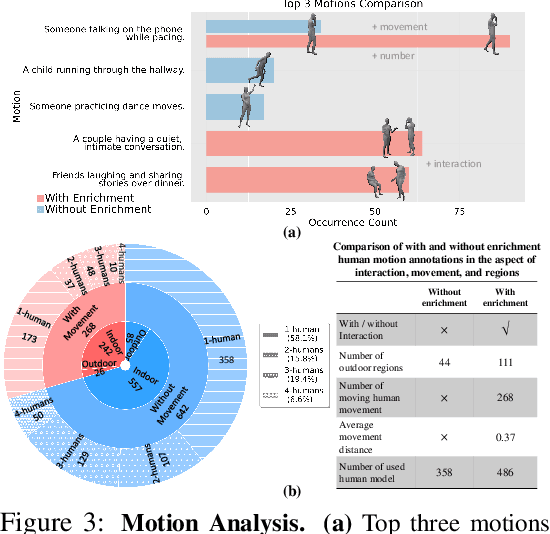

Abstract:Vision-and-Language Navigation (VLN) systems often focus on either discrete (panoramic) or continuous (free-motion) paradigms alone, overlooking the complexities of human-populated, dynamic environments. We introduce a unified Human-Aware VLN (HA-VLN) benchmark that merges these paradigms under explicit social-awareness constraints. Our contributions include: 1. A standardized task definition that balances discrete-continuous navigation with personal-space requirements; 2. An enhanced human motion dataset (HAPS 2.0) and upgraded simulators capturing realistic multi-human interactions, outdoor contexts, and refined motion-language alignment; 3. Extensive benchmarking on 16,844 human-centric instructions, revealing how multi-human dynamics and partial observability pose substantial challenges for leading VLN agents; 4. Real-world robot tests validating sim-to-real transfer in crowded indoor spaces; and 5. A public leaderboard supporting transparent comparisons across discrete and continuous tasks. Empirical results show improved navigation success and fewer collisions when social context is integrated, underscoring the need for human-centric design. By releasing all datasets, simulators, agent code, and evaluation tools, we aim to advance safer, more capable, and socially responsible VLN research.
MaxSup: Overcoming Representation Collapse in Label Smoothing
Feb 18, 2025
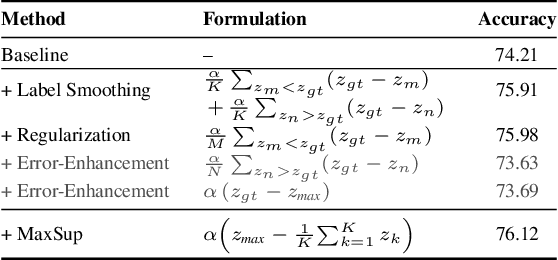
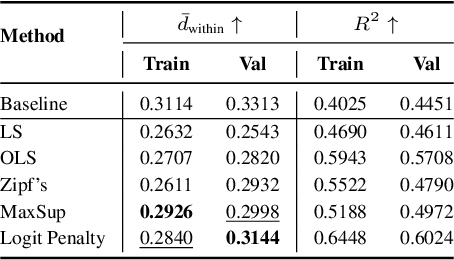
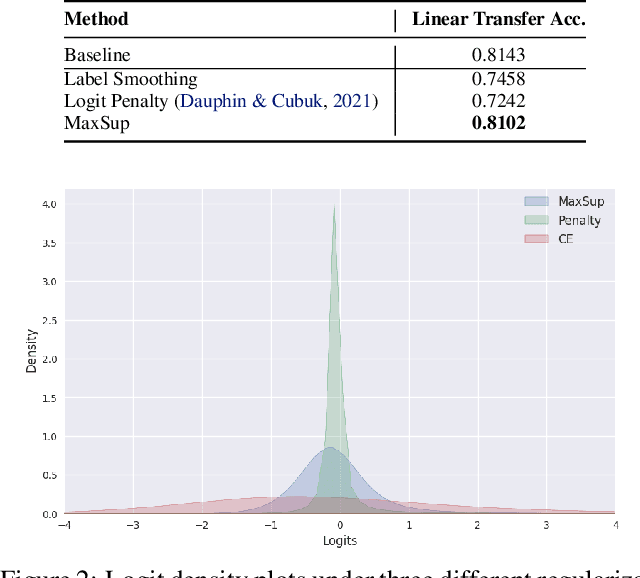
Abstract:Label Smoothing (LS) is widely adopted to curb overconfidence in neural network predictions and enhance generalization. However, previous research shows that LS can force feature representations into excessively tight clusters, eroding intra-class distinctions. More recent findings suggest that LS also induces overconfidence in misclassifications, yet the precise mechanism remained unclear. In this work, we decompose the loss term introduced by LS, revealing two key components: (i) a regularization term that functions only when the prediction is correct, and (ii) an error-enhancement term that emerges under misclassifications. This latter term compels the model to reinforce incorrect predictions with exaggerated certainty, further collapsing the feature space. To address these issues, we propose Max Suppression (MaxSup), which uniformly applies the intended regularization to both correct and incorrect predictions by penalizing the top-1 logit instead of the ground-truth logit. Through feature analyses, we show that MaxSup restores intra-class variation and sharpens inter-class boundaries. Extensive experiments on image classification and downstream tasks confirm that MaxSup is a more robust alternative to LS. Code is available at: https://github.com/ZhouYuxuanYX/Maximum-Suppression-Regularization.
A Video-grounded Dialogue Dataset and Metric for Event-driven Activities
Jan 30, 2025



Abstract:This paper presents VDAct, a dataset for a Video-grounded Dialogue on Event-driven Activities, alongside VDEval, a session-based context evaluation metric specially designed for the task. Unlike existing datasets, VDAct includes longer and more complex video sequences that depict a variety of event-driven activities that require advanced contextual understanding for accurate response generation. The dataset comprises 3,000 dialogues with over 30,000 question-and-answer pairs, derived from 1,000 videos with diverse activity scenarios. VDAct displays a notably challenging characteristic due to its broad spectrum of activity scenarios and wide range of question types. Empirical studies on state-of-the-art vision foundation models highlight their limitations in addressing certain question types on our dataset. Furthermore, VDEval, which integrates dialogue session history and video content summaries extracted from our supplementary Knowledge Graphs to evaluate individual responses, demonstrates a significantly higher correlation with human assessments on the VDAct dataset than existing evaluation metrics that rely solely on the context of single dialogue turns.
UCDR-Adapter: Exploring Adaptation of Pre-Trained Vision-Language Models for Universal Cross-Domain Retrieval
Dec 14, 2024



Abstract:Universal Cross-Domain Retrieval (UCDR) retrieves relevant images from unseen domains and classes without semantic labels, ensuring robust generalization. Existing methods commonly employ prompt tuning with pre-trained vision-language models but are inherently limited by static prompts, reducing adaptability. We propose UCDR-Adapter, which enhances pre-trained models with adapters and dynamic prompt generation through a two-phase training strategy. First, Source Adapter Learning integrates class semantics with domain-specific visual knowledge using a Learnable Textual Semantic Template and optimizes Class and Domain Prompts via momentum updates and dual loss functions for robust alignment. Second, Target Prompt Generation creates dynamic prompts by attending to masked source prompts, enabling seamless adaptation to unseen domains and classes. Unlike prior approaches, UCDR-Adapter dynamically adapts to evolving data distributions, enhancing both flexibility and generalization. During inference, only the image branch and generated prompts are used, eliminating reliance on textual inputs for highly efficient retrieval. Extensive benchmark experiments show that UCDR-Adapter consistently outperforms ProS in most cases and other state-of-the-art methods on UCDR, U(c)CDR, and U(d)CDR settings.
StableAnimator: High-Quality Identity-Preserving Human Image Animation
Nov 26, 2024Abstract:Current diffusion models for human image animation struggle to ensure identity (ID) consistency. This paper presents StableAnimator, the first end-to-end ID-preserving video diffusion framework, which synthesizes high-quality videos without any post-processing, conditioned on a reference image and a sequence of poses. Building upon a video diffusion model, StableAnimator contains carefully designed modules for both training and inference striving for identity consistency. In particular, StableAnimator begins by computing image and face embeddings with off-the-shelf extractors, respectively and face embeddings are further refined by interacting with image embeddings using a global content-aware Face Encoder. Then, StableAnimator introduces a novel distribution-aware ID Adapter that prevents interference caused by temporal layers while preserving ID via alignment. During inference, we propose a novel Hamilton-Jacobi-Bellman (HJB) equation-based optimization to further enhance the face quality. We demonstrate that solving the HJB equation can be integrated into the diffusion denoising process, and the resulting solution constrains the denoising path and thus benefits ID preservation. Experiments on multiple benchmarks show the effectiveness of StableAnimator both qualitatively and quantitatively.
ProMQA: Question Answering Dataset for Multimodal Procedural Activity Understanding
Oct 29, 2024Abstract:Multimodal systems have great potential to assist humans in procedural activities, where people follow instructions to achieve their goals. Despite diverse application scenarios, systems are typically evaluated on traditional classification tasks, e.g., action recognition or temporal action segmentation. In this paper, we present a novel evaluation dataset, ProMQA, to measure system advancements in application-oriented scenarios. ProMQA consists of 401 multimodal procedural QA pairs on user recording of procedural activities coupled with their corresponding instruction. For QA annotation, we take a cost-effective human-LLM collaborative approach, where the existing annotation is augmented with LLM-generated QA pairs that are later verified by humans. We then provide the benchmark results to set the baseline performance on ProMQA. Our experiment reveals a significant gap between human performance and that of current systems, including competitive proprietary multimodal models. We hope our dataset sheds light on new aspects of models' multimodal understanding capabilities.
Emphasizing Discriminative Features for Dataset Distillation in Complex Scenarios
Oct 22, 2024
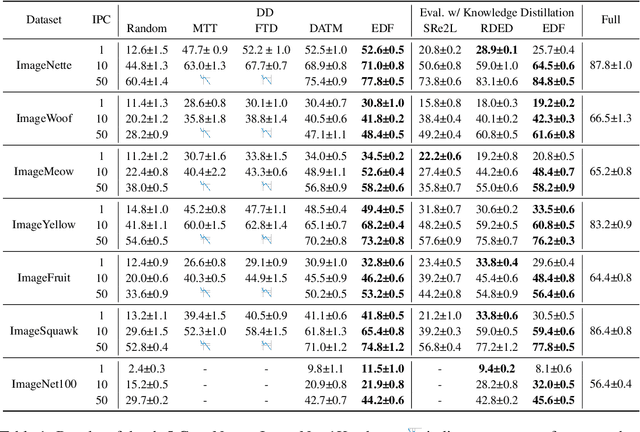
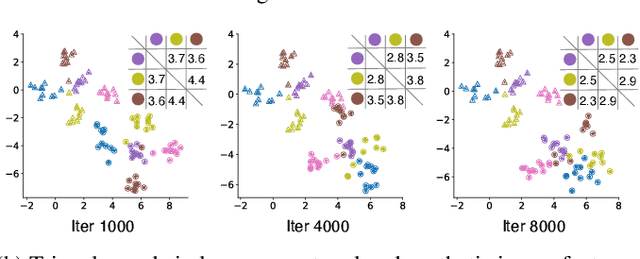

Abstract:Dataset distillation has demonstrated strong performance on simple datasets like CIFAR, MNIST, and TinyImageNet but struggles to achieve similar results in more complex scenarios. In this paper, we propose EDF (emphasizes the discriminative features), a dataset distillation method that enhances key discriminative regions in synthetic images using Grad-CAM activation maps. Our approach is inspired by a key observation: in simple datasets, high-activation areas typically occupy most of the image, whereas in complex scenarios, the size of these areas is much smaller. Unlike previous methods that treat all pixels equally when synthesizing images, EDF uses Grad-CAM activation maps to enhance high-activation areas. From a supervision perspective, we downplay supervision signals that have lower losses, as they contain common patterns. Additionally, to help the DD community better explore complex scenarios, we build the Complex Dataset Distillation (Comp-DD) benchmark by meticulously selecting sixteen subsets, eight easy and eight hard, from ImageNet-1K. In particular, EDF consistently outperforms SOTA results in complex scenarios, such as ImageNet-1K subsets. Hopefully, more researchers will be inspired and encouraged to improve the practicality and efficacy of DD. Our code and benchmark will be made public at https://github.com/NUS-HPC-AI-Lab/EDF.
 Add to Chrome
Add to Chrome Add to Firefox
Add to Firefox Add to Edge
Add to Edge